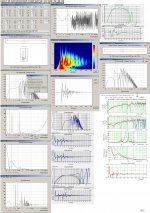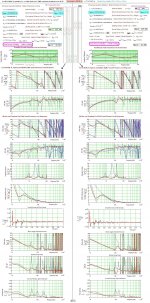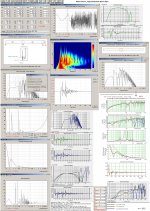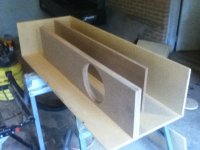Starting a project of bringing my JBL 12" 2214H's back to life in my home system. What size and type of cabinet to build? Of course, my goal is going as low as I can go. Room size, is not a factor they can be big if they need to be. Using a receiver a Pioneer DSX-914 at 110 watts. Thinking to myself, "just go to the experts for this". These are just my numbers, that I have. Thanks for the help.
JBL 2214H PMAX=200 RE=5.6
FS=23 XMAX=.26 LE=1.3
QTS=.24 DIA=10.2
VAS=7.9 QMS=10.5
EFF=1.1% QES=.25
JBL 2214H PMAX=200 RE=5.6
FS=23 XMAX=.26 LE=1.3
QTS=.24 DIA=10.2
VAS=7.9 QMS=10.5
EFF=1.1% QES=.25
That looks amazing. What are the actual dimensions for the box and ports?
Hi jayhue,
Have a look at the submitted picture and you will find a few of the dimensions needed. I didn't exactly know the driver frame width (calculated with 31 cm) or the needed depth for magnet clearance when I made the simulation.
I think if you start with an internal box height of( L23 + 2 x 31 cm+ 1.8cm(Choose the baffle thickness = 2 x 1.8cm) + the internal box width = 31 cm and a L23= 223.25 cm:
The total L would be slightly lower than 450 cm.( When damping material is added to the box: The effective length of the air-ways are 'virtual' longer than if physically measured.)
b
Attachments
Last edited:
I think if you start with an internal box height of( L23 + 2 x 31 cm+ 1.8cm(Choose the baffle thickness = 2 x 1.8cm) + the internal box width = 31 cm and a L23= 223.25 cm:
b
Woa, you just blew my head off so please educate me. What is L23? If Jay can provide the external dimensions including mounting hole size and depth we should be able to bang this one out.
-Stu
Woa, you just blew my head off so please educate me. What is L23? If Jay can provide the external dimensions including mounting hole size and depth we should be able to bang this one out.
-Stu
Hi Stu,
You will find L23 to be the 'in enclosure' the inter driver section distance between the rear to the front side if you download and enter the numbers given into the free Hornresp program.
b
The new hornresp program has different input par. than the one showing. What is this type of enclosure called. The internal length of the baffles? Spacing of the baffles inside the enclosure. Is there a page for the wood cuts? I can build this with just a little more help. Thanks. jayhue
Just a few more measurements and I can start building. Length of the baffles? Dying to start this build. Please, Please, Please. thanks.
Hi jayhue,
Sorry for being late.
For the moment: Here's a revised picture with some added dimensions to study:
b
Attachments
Last edited:
That looks like enough information to start building the cabinets with. My only question at this point is with securing the front panel to the cabinet. Since the driver is internal, the front panel needs to be removable in case something goes bad with the driver. One easy way I can think of is to use button caps (screw covers) on the panel. Is there a better or more preferred way to do this?
Thanks. Starting this build. Where in the enclosure dose the stuffing go? Middle and the rear sections?
Hi,
Stuff evenly/carefully using recommended weight of stuffing material:
Counted from the closed end to halfways down the line.
Mandatory:Insert bracings(dowels <= a foot between)) in this volume too.
If necessary:Trim the 3/4 wave dip with denser stuffing near the S1 area.
b
bjorno: fabulous, fabulous, fabulous, Worked on the build all weekend long. I have one of my 2214's in a ported box. The other is sitting in your "monster" tapped horn enclosure design. The comparison not even close. The low side is smooth as silk. Thanks for your help.
Pictures of the build?
bjorno: fabulous, fabulous, fabulous, Worked on the build all weekend long. I have one of my 2214's in a ported box. The other is sitting in your "monster" tapped horn enclosure design. The comparison not even close. The low side is smooth as silk. Thanks for your help.
Pictures of the build?
That looks like enough information to start building the cabinets with. My only question at this point is with securing the front panel to the cabinet. Since the driver is internal, the front panel needs to be removable in case something goes bad with the driver. One easy way I can think of is to use button caps (screw covers) on the panel. Is there a better or more preferred way to do this?
An externally hosted image should be here but it was not working when we last tested it.
An externally hosted image should be here but it was not working when we last tested it.
Jayhue,
All the simulations in this thread are for using two drivers(labeled 2P in HR and in MJK= 2 x SD + Re/2)) in parallel and if only one driver is used the CSA's should be divided by two in order to optimal fit one driver.
I checked using one driver: Will work too if you are easy when turning the volume knob on your amp.
b
- Status
- This old topic is closed. If you want to reopen this topic, contact a moderator using the "Report Post" button.
- Home
- Loudspeakers
- Subwoofers
- Building a cabnet for a pair of JBL 2214's




![IMG_1518[1].JPG IMG_1518[1].JPG](https://www.diyaudio.com/community/data/attachments/292/292810-20b77afdb964bb7e5de00393c1db4f1f.jpg)